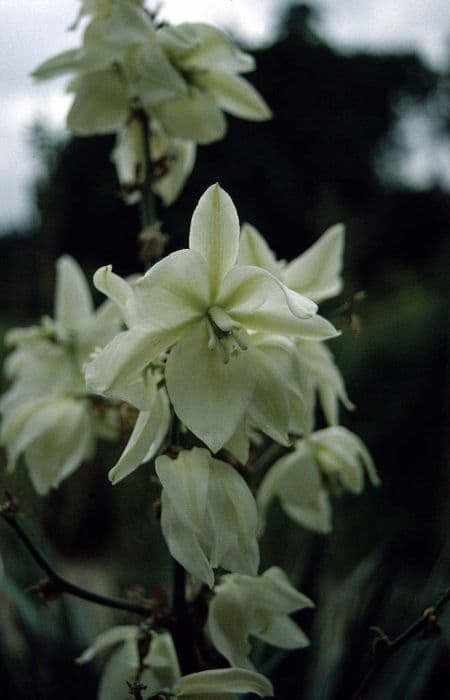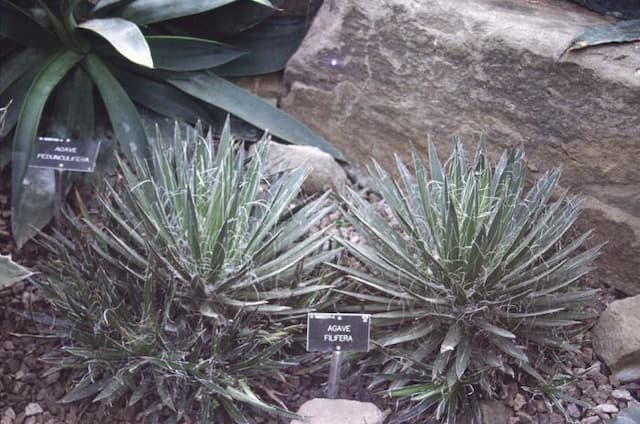Needle palm Yucca filamentosa

ABOUT
a small stemless evergreen shrub forming clumps of sword-shaped, deep green leaves to 75cm in length, edged with curly filaments. Nodding creamy-white flowers 6cm in length are borne in panicles to 2m in height in late summer
About this plant
 Names
NamesFamily
Asparagaceae
Synonyms
Adam's Needle, Spoonleaf Yucca, Filament Yucca, Bear Grass
Common names
Yucca filamentosa var. smalliana, Yucca smalliana, Yucca flaccida.
 Characteristics
CharacteristicsLife cycle
Perennials
Foliage type
Evergreen
Color of leaves
Green
Flower color
White
Height
3-4 feet (0.9-1.2 meters)
Spread
2-3 feet (0.6-0.9 meters)
Plant type
Shrub
Hardiness zones
4-11
Native area
Southeastern United States
Benefits
 General Benefits
General Benefits- Drought Tolerance: Yucca filamentosa is highly resistant to drought, making it an excellent choice for xeriscaping and low-water gardens.
- Low Maintenance: It requires minimal care once established, with little need for watering, pruning, or fertilization.
- Landscape Design: Its rosettes of sword-shaped leaves and tall flower spikes provide striking architectural interest in garden designs.
- Soil Erosion Control: The extensive root system can help stabilize soil and prevent erosion on slopes or in areas prone to soil degradation.
- Attracts Wildlife: The flowers of Yucca filamentosa are known to attract pollinators like moths and butterflies.
- Habitat: It can serve as a habitat plant for certain species, including the Yucca Moth, which is the exclusive pollinator of yuccas.
- Deer Resistance: The plant is typically resistant to browsing by deer due to its tough foliage.
- Evergreen: Yucca filamentosa retains its foliage year-round, providing continuous visual interest even in winter.
 Medical Properties
Medical Properties- Anti-inflammatory: Yucca filamentosa may contain compounds that help reduce inflammation.
- Arthritis relief: The saponins in the plant might be beneficial for people suffering from arthritis symptoms.
- Antioxidant: Yucca filamentosa could have antioxidant properties that help protect the body from oxidative stress.
- Saponin content: Due to the presence of saponins, the plant may be used for its potential to aid in the absorption of nutrients and improve digestive health.
 Air-purifying Qualities
Air-purifying QualitiesThis plant is not specifically known for air purifying qualities.
 Other Uses
Other Uses- Soap and shampoo: The roots of Yucca filamentosa contain saponins, which lather when mixed with water, making them useful for creating natural soaps and shampoos.
- Bio-materials: Fibers from Yucca filamentosa leaves can be used in the production of biodegradable plastics and other eco-friendly materials.
- Rope and cordage: The strong fibers extracted from the leaves have traditionally been used for making ropes and twines.
- Basketry: The Native Americans utilized the plant's flexible leaves for basket weaving and other fiber arts.
- Fish poison: Historically, the saponin-rich roots were sometimes used by indigenous peoples to stun fish, making them easier to catch.
- Photography: The juice of Yucca filamentosa can be used in the alternative photographic process known as anthotype, where plant juices are used to create images on paper.
- Dye: The roots and leaves can be used to produce natural dyes for textiles, yielding colors ranging from yellow to green.
- Garden landscaping: With its tall spikes of creamy white flowers, Yucca filamentosa is popular as an ornamental plant in xeriscaping and drought-resistant gardens.
- Horticultural therapy: Gardening with Yucca filamentosa and other plants can provide therapeutic benefits to people engaging in horticultural therapy programs.
- Compost material: The leaves, when dried and shredded, can be used as a carbon-rich material for composting, helping to balance the compost pile's nutrients.
Interesting Facts
 Feng Shui
Feng ShuiThe Adam's needle is not used in Feng Shui practice.
 Zodiac Sign Compitability
Zodiac Sign CompitabilityThe Adam's needle is not used in astrology practice.
 Plant Symbolism
Plant Symbolism- Protection – Yucca filamentosa, commonly known as Adam's Needle, has sharp, sword-like leaves that are seen as symbols of protection, warding off negative influences and energies.
- Purity – The white, bell-shaped flowers of Adam's Needle are often associated with purity and cleanliness, possibly due to their crisp and bright appearance.
- Survival and Resilience – Adam's Needle is known for its ability to withstand tough conditions, symbolizing tenacity, survival, and the capability to thrive in challenging environments.
- Transformation – This plant can endure and adapt to various climates, symbolizing personal growth and the ability to change and evolve through different life circumstances.
- New Opportunities – The blooming of Adam's Needle signifies new beginnings and opportunities, as it is a plant that can take root in diverse and unforgiving terrains.
 Water
WaterAdam's needle requires minimal watering as it is a drought-tolerant plant. Water the plant sparingly, only when the top few inches of soil are completely dry. Typically, watering every 7 to 10 days during the growing season and much less during winter, about once a month, is sufficient. Deeply water the plant with approximately one gallon per plant, ensuring you saturate the soil around the root zone each time. Overwatering can lead to root rot, so it's crucial to let the soil dry out between watering sessions.
 Light
LightAdam’s needle thrives in full sunlight and can handle direct, bright light for most of the day. The best spot for this plant is in an area where it will receive at least six hours of sunlight daily. However, it is adaptable enough to tolerate partial shade, especially in the hottest parts of the day, but its growth might be less robust.
 Temperature
TemperatureAdam's needle does well in a wide range of temperatures and is quite cold hardy. It can withstand temperatures as low as 5 degrees Fahrenheit and as high as 90 degrees Fahrenheit. Ideally, maintaining a temperature range between 60 to 80 degrees Fahrenheit will promote good health and growth for the plant.
 Pruning
PruningPruning Adam's needle is generally done to remove spent flower stalks and tidy up any dead or damaged leaves. Pruning is best performed in the spring, after the last frost has passed. It's not necessary to prune this plant frequently; once a year is often enough, focusing on maintaining its natural shape and health.
 Cleaning
CleaningAs needed
 Soil
SoilAdam's needle thrives in well-draining soil with a pH between 5.5 and 7.5. A mix of 50% garden soil, 30% sand, and 20% perlite provides good drainage and aeration. Amend the soil with compost to improve nutrient content.
 Repotting
RepottingAdam's needle is typically slow-growing and does not need frequent repotting. Repot every 2 to 3 years to refresh the soil and address any root-bound issues.
 Humidity & Misting
Humidity & MistingAdam's needle is tolerant of dry air conditions and does not require high humidity, making it ideal for typical indoor environments.
 Suitable locations
Suitable locationsIndoor
Place Adam's needle in bright, indirect light and avoid overwatering.
Outdoor
Plant Adam's needle in sunny spot with well-draining soil.
Hardiness zone
4-10 USDA
 Life cycle
Life cycleAdam's needle (Yucca filamentosa) begins its life as a seed that germinates in spring, ideally in well-drained sandy soil under full sun. Once the seedling emerges, it develops basal rosettes of sharp-edged, sword-shaped leaves during its juvenile phase. Over the years, as the plant matures, it forms a short, woody stem from which these rosettes continue to grow and spread. The plant reaches maturity and begins its reproductive phase when it sends up a tall flower stalk, typically in late spring or early summer, which bears white, bell-shaped flowers that are pollinated by moths. After pollination, seed pods form, and when they dry, they release seeds, thereby completing the reproductive cycle. Alongside sexual reproduction, Adam's needle may also propagate vegetatively through offsets, which emerge around the base of the parent plant and can be separated to grow new plants.
 Propogation
PropogationPropogation time
Spring-Early Summer
Adam's needle is typically propagated through division, which is the most popular method. The best time to propagate Adam's needle by division is in early spring, just as new growth is beginning. To do so, carefully dig around the base of an established plant, lifting it from the ground. You should see natural divisions, or 'offsets,' which can be pulled or cut apart with a sharp knife, ensuring that each division has a portion of the roots attached. The divisions are then replanted in well-draining soil where they will establish themselves and grow into new plants. It's important to give the new sections plenty of water during the first growing season to help establish the root system, typically measured in terms of inches per week - about 1 inch (2.54 centimeters) is a reasonable guideline.









